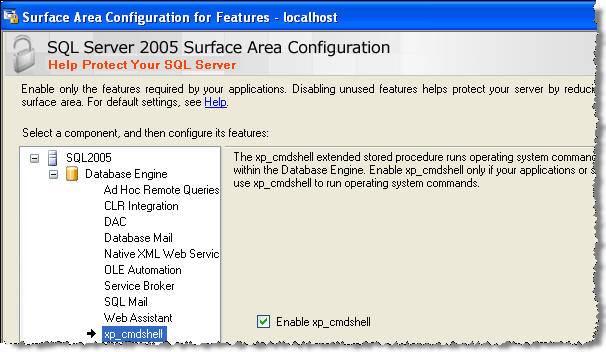Since the transition from DTS to SSIS, I have found myself looking for alternative ways to do simple tasks such as exporting data from SQL Server into text files. SSIS is a far more powerful tool than DTS, but I generally try to stay away from it for simple operations. With the combination of a few T-SQL commands this tip shows you a simple way to export data to text files.
Solution
One of the ways I have worked around this is by using bcp with xp_cmdshell. It's fast, easy and I can integrate it right into my code.
The first thing you have to do is make sure xp_cmdshell is enabled. You can do this in one of two ways.
1. You can use sp_configure and execute the following script.
| EXEC master.dbo.sp_configure 'show advanced options', 1 RECONFIGURE EXEC master.dbo.sp_configure 'xp_cmdshell', 1 RECONFIGURE |
2. You can use the Surface Area Configuration Tool.
Select Surface Area Configuration for Features and check the Enable xp_cmdshell checkbox.

Now that you have xp_cmdshell enabled you are ready to export your files.
Here is a sample command that will export the results of the sysfiles table to a comma delimited file called bcptest.txt. Just copy and paste this into a query window and execute the query.
| EXEC xp_cmdshell 'bcp "SELECT * FROM sysfiles" queryout "C:\bcptest.txt" -T -c -t,' |
This is the output for the above command when run in the "master" database.

- The queryout option allows you to specify a query to export. This could be as simple as the query we have are as complicated as you want. You can also create a view and select the data from a view.
- The file name where the results will be stored is placed after the queryout option.
- The -T parameter specifies that the bcp utility connects to SQL Server with a trusted connection using integrated security. You could use -P (password) and -U (user) if you want to use a SQL Server login.
- The -c specifies the character dataype will be used for each field.
- The -t parameter allows you to specify a field delimiter. The character after -t will be used to separate the data fields. If -t is removed, tab will be used as the default delimiter.
| EXEC xp_cmdshell 'bcp "select name, type_desc, create_date from sys.objects" queryout "C:\bcptest2.txt" -T -SDEVELOP\DEV1 -c -t,' |
Next Steps
- You can find out more about the BCP utility and all of the available parameters on MSDN. http://msdn.microsoft.com/en-us/library/ms162802.aspx
- Review the following tip on enabling xp_cmdshell
- Here are additional tips on exporting data
- SQL Server 2000 vs SQL Server 2005 Integration Services SSIS Import and Export Wizard
- Export data from SQL Server to Excel
Source : http://www.mssqltips.com/tip.asp?tip=1633









0 komentar:
Posting Komentar